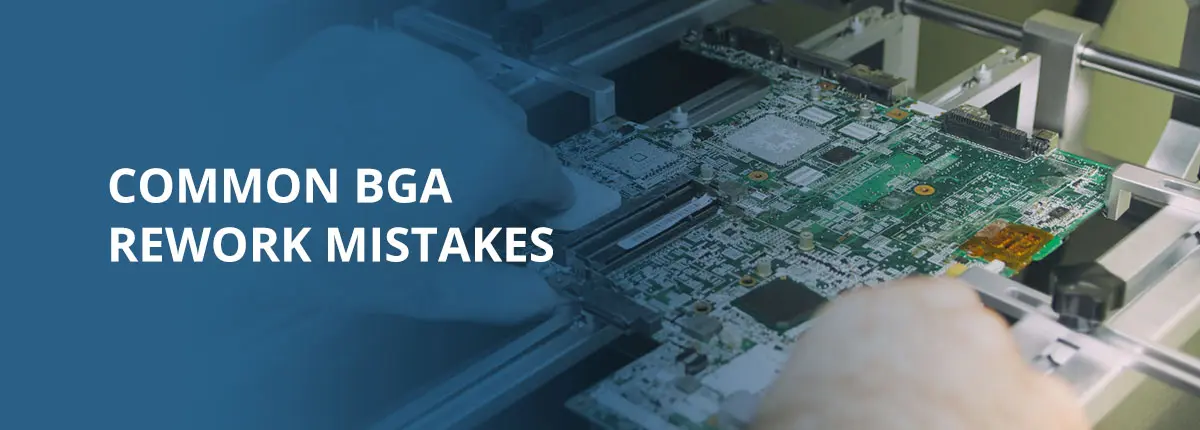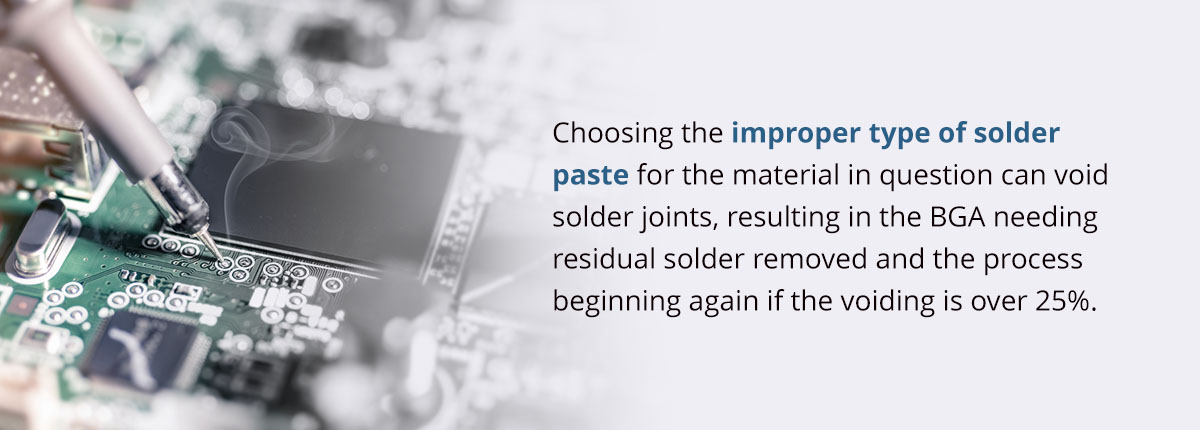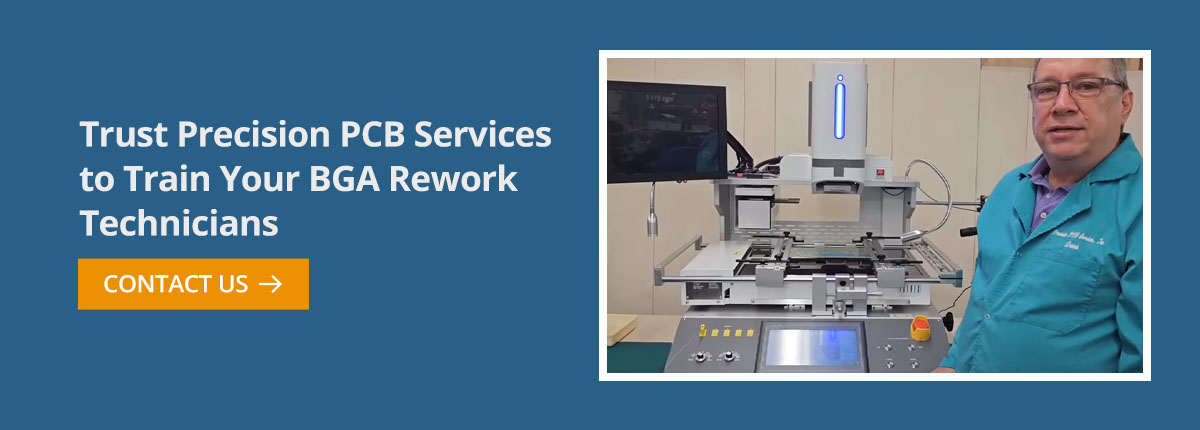Common BGA Rework Mistakes
Reworking a ball grid array (BGA) is one of the most challenging operations when it comes to repairing or assembling a printed circuit board (PCB). The reason for this difficulty is because of the unique nature of BGAs — they are designed to permanently mate the PCB and integrate the circuit, which makes getting to the connecting pins — or heating the entire device to the heating point of the solder, possibly ruining it — almost impossible.
One of the most common reasons for BGA repair and rework is the fact that the balls of tin solder, the “ball” in the ball grid array, can become unreliable due to the continuous heating and shrinking of the board or its components as caused by the normal heating cycle of the board.
While the procedures for BGA rework are well-defined, several different rework issues and mistakes can happen over a standard BGA repair or rework. These complications can lead to either a series of costly repairs or being forced to scrap the BGA entirely and start anew. That's why we created this guide about the common BGA rework mistakes and challenges of BGA inspection to improve your PCB operations. So, to start from the top, we’ll go over the steps of a BGA repair first.
What Are the Steps of BGA Repair?
Before we can explore the challenges of BGA inspection, it's crucial to understand the process itself. Here are the four essential steps of BGA repair.
- First, remove the components, such as the PCB. Preheat the PCB until the solder becomes molten, and then remove the PCB with a vacuum. Be careful of damage to the BGA pads when you remove the BGA itself. Without properly heating the BGA or allowing it to achieve full saturation and flow of the solder, attempting to remove the BGA pads can make the entire component much more expensive to fix.
- Next, remove the residual solder. Have the site fixtures, and then preheat it again with a vacuum to remove the old and excess solder.
- Reball BGA. Once you have removed all the excess solder, reball the BGA. Reballing involves using a stencil to set new spheres of solder into the BGA.
- Re-solder and reattach all components. After removing the excess solder and reballing the BGA, you'll be able to re-solder and reattach the components and PCB. This process is much like the component removal from step one, except that now you can print the solder onto either the PCB or BGA as necessary before soldering begins.
What Are Some Common Causes of BGA Rework Mistakes?
It’s easy enough from the overview above to get a sense of how the BGA rework process should flow. Even so, mistakes still happen. Here are some of the most common ways a BGA repair goes south:
Inadequate Operator Training
BGA repair technicians need to be well-trained, with a practiced, developed skill set. Part of this experience is understanding what materials they’re working with, how they interact and how their tool selection can impact this. Another facet is a solid working knowledge of the process of BGA repair, as well as being able to evaluate a potential repair situation before work commences.
While the repair process seems simple enough, you need to consider several things when it comes to the finer points of BGA repair and it’s these things that a repair technician needs to know when they undertake a BGA repair. Some of these BGA repair considerations technicians should learn during training include:
- Soldering and identifying the different types of wires and terminals
- Improving hands-on rework, assembly and soldering skills
- Meeting quality assurance standards in compliance with IPC-a-610F
- Understanding techniques for reballing BGA components
- Repairing PCBs and electronic assemblies correctly
- Complying with IPC 7095 guidelines for operating rework stations correctly
Additionally, technicians should be aware of things like:
- The possibility of thermal mismatch between the PCB and BGA
- The possibility of solder heat liquefying other components
- Correct thermal and flow management procedures
Improper Preparation
Whether it’s a simple rework or a full-on BGA repair, the key to a job that lasts a long time is in how the technician prepares for it. As explained by the process above, a lot of preparation goes into a proper BGA job and knowing that your technician is taking those steps can bring some peace of mind.
Long before they touch the BGA, there is research that the technician needs to do and decisions that they need to make. They need to make an accurate assessment of the BGA’s solder ball size to ensure they’re using the right size, and then they need to check things like the coplanarity of the solder balls and the rest of the device.
Once the technician does this research, they can make a couple of decisions, such as whether they want to use solder paste, what they think the right stencil is for the job and choosing the suitable alloys and chemistry to ensure success.
After they’ve done research and made the decisions, there are several things a good technician can do before a repair that can make or break it, including:
- Assessing damage to the solder mask
- Checking for contaminated or missing pads at the PCB site
- Taking preparatory steps, such as baking the moisture of the PCB and BGA and removing or otherwise shielding heat-sensitive components to prevent possible damage or reflow
Incorrect Equipment Selection or Improper Material Choices
This goes hand in hand with the earlier point about improper preparation because, as they say, you need the right tools to get the job done. The equipment a technician uses to fix BGA rework issues needs to be flexible, capable of performing some tasks and also capable of standing up to repeated use in a controlled process.
A technician must choose the best and most suitable equipment for a job. Here are some aspects to take into consideration when selecting the correct equipment:
- Get equipment with a collection of abilities and options, like closed-loop thermal sensing and control and producing heat when and where the process requires.
- Ensure your equipment gives you the ability to handle products as needed, both for part removal and part replacement.
- Choose top-quality equipment and refrain from cutting corners to reduce the amount of BGA rework issues you might face in the future.
When making the right material choices and selecting the correct equipment, you can avoid BGA rework mistakes like solder joints voided by excessive solder. Choosing the improper type of solder paste for the material in question can void solder joints, resulting in the BGA needing residual solder removed and the process beginning again if the voiding is over 25%. Other possibilities include flat-out rejection of the BGA in question or simply additional rework, especially if the excess compromises the solder attachment points.
Poor Development of the BGA Rework Profile
Developing a proper thermal profile for the individual components in your BGA rework or repair is one of the most important things you can do. Knowing what constitutes an adequate profile saves you time and effort and reduces the incidence of rework and repair issues.
Since the process for BGA rework and repair is a repeated process, you need to have the proper thermal profiles for your components to ensure you can assemble a successful, repeatable BGA repair or rework process.
Having a poorly developed thermal profile means an increased chance of damage to the BGA, the PCB or other components, meaning you’ll spend more time reworking the same site. The best way to develop a good thermal profile is to ensure that your thermocouples are properly placed (especially when it comes to the PCB) and then analyze the data they provide you. Only with good, solid data can you put together a workable, repeatable thermal profile.
Collateral Heat Damage
Collateral heat damage is one of the things that can happen if your chosen materials have improperly profiled thermal properties. As the name implies, collateral heat damage harms nearby components and leads to a host of other BGA rework issues, depending on which component was damaged and how.
Having solder from adjacent components reflow after it has set can also lead to various other issues as things progress. Some of these issues might include:
- Pad damage
- Solder oxidation
- Lead damage
- Starved joints
- De-wetting
- Component damage
- Wicking
A good technician needs to be aware of where they are directing heat and how much heat they’re directing. Depending on the materials involved, the right temperature for one component may be catastrophic for another. Having a well-developed thermal profile for all of your components and tight process control can help minimize the migration of heat away from reworking the component, preventing future headaches in the process.
Insufficient or Improper Post-Placement Inspection
BGA components can be complex pieces of tech, and the world beneath them can often seem like some mysterious, confusing place. That's why it's essential to conduct BGA inspections to avoid any defects and ensure solder connections are successful. There are three main inspection techniques and tools to help technicians achieve this:
- Optical: Optical medical tools like endoscopes can assist technicians in revealing small defects the human eye might miss.
- Electric: This method involves an electric current that runs through the BGA to assess its stability.
- X-ray: This advanced option uses X-ray radiation to provide technicians with detailed imagery of variances in solder joint patterns.
Given how advanced X-ray inspection machines have become, it’s much easier for a technician to find and diagnose common BCA rework issues through this method. Issues that would once require costly disassembly to diagnose, such as poor alignment, poor placement or excessive voiding, you can now diagnose by simply looking at an X-ray.
However, a technician still needs to be trained in the use of an X-ray machine. They need to be able to properly understand the image the machine is showing and then interpret the data provided by that image.
An improperly oriented BGA is one of the most common problems you can spot using proper post-placement inspection techniques. Fixing the orientation means more rework cycles and the increased possibility of heat damage to the BGA itself and surrounding components.
One other issue when it comes to BGA rework and repair is the overall BGA design. Manufacturers are increasingly tending toward ultra-fine (0.3 mm) pitch BGAs in their devices. Pitch is the space between the center of one ball in the BGA to the center in the next. As the space between the two balls decreases with the drive toward smaller and smaller components, manufacturers have striven to try and increase functionality within the same amount of real estate.
However, this can get complicated when using the incorrect design specifications. Since most BGAs in current use are 0.5 mm or 0.4 mm, designing a 0.3 mm BGA using these exact specifications will result in design missteps, especially when it comes to the layout of vias and lands. The “land” of a PCB is what the BGA device balls sit up against and eventually get soldered to. It connects via a circuit called a “fan out” to the “via,” which distributes on/off and power signals from the device to its peripherals.
These design specifications can seem complicated because, in producing 0.5 and 0.4 mm BGAs, the industry is already pushing its manufacturing capabilities to their limits. In recent times, tolerances have usually been around 3 mm, with the new push to produce 0.3 mm BGAs moving things closer to the +/- 1 mm range. The tightened tolerances of these new specifications require additional equipment for validation and rework. Required 3D X-rays, along with advanced placement and rework stations, will certainly exist in the future.
Board fabrication and assembly are already challenging enough. The PCB designer, rework and repair technicians need to show diligence when it comes to working with fine-pitch BGAs, especially about possible complications such as the type of solder paste or underfills used, the type and thickness of stencil used for placing the BGA balls and other general equipment tolerances.
Poor BGA Rework Stations
To carry out BGA rework correctly, it's essential to have the right setup. The equipment every technician should have in their BGA rework station includes:
- Supplementary electronics, software and components
- Pressure-adjustable suction tool
- Cameras
- Adjustable X-Y table
- Split-beam prism alignment system
- Temperature-controlled system
With the right equipment, your BGA rework station can accommodate various PCB sizes and cater to specialized tools that allow technicians to work faster, complete tasks accurately and pay attention to detail. However, it's equally important to maintain tools and equipment to prevent vital components from breaking down. These issues can result in workflow disruptions, increased downtime and increased costs to fix equipment.
To prevent the need for emergency repairs, technicians must follow these best practices for maintenance and upkeep:
- Use high-quality solder paste: Low-quality solder may have impurities that can build up on the gun tip.
- Only touch the soldering iron tip with soft material: Rough materials like sandpaper may damage the solder, so it's best to use a sponge or soft cloth.
- Clean gun tip after each use: Be sure to flood the gun tip with high-quality solder before unplugging the machine.
- Follow manufacturer instructions for specialized components: Following the manufacturer's instructions can help you work without unexpected interruptions.
Trust Precision PCB Services to Train Your BGA Rework Technicians
Precision PCB Services is an industry expert when it comes to BGA rework and repair. We offer a variety of courses set up specifically to cater to your needs. We have courses on everything from lead/lead-free solder for companies that use both technologies to BGA rework, BGA reballing and even a class on BGA rework process implementation if you’re looking to set up your own BGA rework departments in-house.
We also offer a wide variety of consulting services for those customers who are looking to get the ball rolling a little smoother. We designed our consulting services with the customer in mind — we want to help you solve the problems that are affecting your business, whether that’s helping you improve your operation’s overall efficiency or helping you keep your equipment in tip-top shape.
Whether you're new to BGA rework and repair and require the right equipment or need to contact a knowledgeable professional about the equipment you need for the type of BGAs you're reworking, we offer several varieties of BGA rework stations and all machines come fully self-contained with their internal air and vacuum unless otherwise specified.
As part of our precision skills training, we also offer operator training and profile development for all the Shuttle BGA rework stations (the SV550, SV560 and SV560A) as well as many others, including SRT, VJ Electronics, Den On, Manncorp, A.P.E. Conceptronics and Zhuomao. Training includes machine setup and operation, calibration training for the vision system and the heaters, as well as thermal profile development for various BGA types, followed by troubleshooting and preventative maintenance courses.
If you have questions or would like to enroll in one of our classes, please look around our website or contact an expert in our team today.


